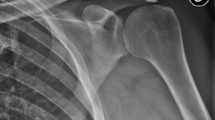Abstract
Introduction
Osteoporosis is a highly focused issue in current scientific research and clinical treatment. Especially in rotator cuff repair, the low bone quality of patients suffering from osteoporosis is an important issue. In this context, non-biological solutions using PMMA for anchor augmentation have been developed in the recent past. The aim of this study was to evaluate whether augmentation of suture anchors using bio-absorbable osteoconductive fiber-reinforced calcium phosphate results in improved failure load of suture anchors as well.
Materials and methods
Altogether 24 suture anchors (Corkscrew FT 1 Suture Anchors, Arthrex, Naples, FL, USA) were evaluated by applying traction until pullout in 12 paired fresh frozen human cadaver humeri using a servo-hydraulic testing machine. Inclusion criteria were an age of more than 64 years, a macroscopically intact RC and an intact bone. The anchors were evaluated at the anterolateral and posteromedial aspect of the greater tuberosity. 12 suture anchors were augmented and 12 suture anchors were conventionally inserted.
Results
The failure load was significantly enhanced by 66.8 % by the augmentation method. The fiber-reinforced calcium phosphate could be easily injected and applied.
Conclusion
The bio-absorbable cement in this study could be a promising augmentation material for RC reconstructions, but further research is necessary—the material has to be evaluated in vivo.




Similar content being viewed by others
References
EU (2011) The 2012 Ageing report: Underlying assumptions and projection methodologies. European Economy 4/2011
Yamaguchi K, Ditsios K, Middleton WD, Hildebolt CF, Galatz LM, Teefey SA (2006) The demographic and morphological features of rotator cuff disease. J Bone Joint Surg 88(8):1699–1704
Hijioka A, Suzuki K, Nakamura T, Hojo T (1993) Degenerative change and rotator cuff tears. An anatomical study in 160 shoulders of 80 cadavers. Arch Orthop Trauma Surg 112(2):61–64
Barber FA, Herbert MA (2013) Cyclic loading biomechanical analysis of the pullout strengths of rotator cuff and glenoid anchors: 2013 update. Arthroscopy J Arthrosc Relat Surg 29(5):832–844
Pietschmann P, Kerschan-Schindl K (2004) Knochenqualität-wissenschaftliche Aspekte versus praktischer Relevanz. J für Mineralstoffwechsel 11(3):24–26
Pietschmann MF, Frohlich V, Ficklscherer A, Gulecyuz MF, Wegener B, Jansson V, Muller PE (2009) Suture anchor fixation strength in osteopenic versus non-osteopenic bone for rotator cuff repair. Arch Orthop Trauma Surg 129(3):373–379. doi:10.1007/s00402-008-0689-4
Kafchitsas K, Geiger F, Rauschmann M, Schmidt S (2010) Zementverteilung bei Vertebroplastieschrauben unterschiedlichen designs. Der Orthopäde 39(7):679–686
Braunstein V, Ockert B, Windolf M, Sprecher CM, Mutschler W, Imhoff A, Postl LK, Biberthaler P, Kirchhoff C (2015) Increasing pullout strength of suture anchors in osteoporotic bone using augmentation—a cadaver study. Clin Biomech (Bristol, Avon) 30(3):243–247. doi:10.1016/j.clinbiomech.2015.02.002
Oshtory R, Lindsey DP, Giori NJ, Mirza FM (2010) Bioabsorbable tricalcium phosphate bone cement strengthens fixation of suture anchors. Clin Orthop Relat Res 468(12):3406–3412. doi:10.1007/s11999-010-1412-7
Krüger R, Groll J (2012) Fiber reinforced calcium phosphate cements—on the way to degradable load bearing bone substitutes? Biomaterials 33(25):5887–5900
Postl L, Braunstein V, von Eisenhart-Rothe R, Kirchhoff C (2013) Footprint reconstruction in a rotator cuff tear associated cyst of the greater tuberosity: augmented anchorage. Arch Orthop Trauma Surg 133(1):81–85
Kirchhoff C, Braunstein V, Milz S, Sprecher CM, Fischer F, Tami A, Ahrens P, Imhoff AB, Hinterwimmer S (2010) Assessment of bone quality within the tuberosities of the osteoporotic humeral head: relevance for anchor positioning in rotator cuff repair. Am J Sports Med 38(3):564–569. doi:10.1177/0363546509354989
Kirchhoff C, Braunstein V, Milz S, Sprecher CM, Kirchhoff S, Graw M, Imhoff AB, Hinterwimmer S (2012) Age and gender as determinants of the bone quality of the greater tuberosity: a HR-pQCT cadaver study. BMC Musculoskelet Disord 13:221. doi:10.1186/1471-2474-13-221
Burkhart SS (1995) The deadman theory of suture anchors: observations along a south Texas fence line. Arthroscopy 11(1):119–123
Ahern BJ, Harten RD, Gruskin EA, Schaer TP (2010) Evaluation of a fiber reinforced drillable bone cement for screw augmentation in a sheep model—mechanical testing. Clin Translat Sci 3(3):112–115
von Rechenberg B, Génot OR, Nuss K, Galuppo L, Fulmer M, Jacobson E, Kronen P, Zlinszky K, Auer JA (2013) Evaluation of four biodegradable, injectable bone cements in an experimental drill hole model in sheep. Eur J Pharm Biopharm 85(1):130–138
Ma CB, Comerford L, Wilson J, Puttlitz CM (2006) Biomechanical evaluation of arthroscopic rotator cuff repairs: double-row compared with single-row fixation. J Bone Joint Surg 88(2):403–410
Clevenger TA, Beebe MJ, Strauss EJ, Kubiak EN (2014) The effect of insertion angle on the pullout strength of threaded suture anchors: a validation of the deadman theory. Arthroscopy J Arthrosc Relat Surg 30(8):900–905
Burkart A, Imhoff A (1999) Ätiologie und Therapie des Impingementsyndroms an der Schulter. Schulterinstabilität—Rotatorenmanschette. Springer, Berlin, pp 163–171
Burkhart SS (2014) The deadman theory is alive and well. Arthroscopy 30(9):1049–1050. doi:10.1016/j.arthro.2014.07.007
Meier SW, Meier JD (2006) Rotator cuff repair: the effect of double-row fixation on three-dimensional repair site. J Shoulder Elbow Surg 15(6):691–696
Acknowledgments
The authors thank Florian Fischer, MD from the department of Forensic for providing the specimens.
Author information
Authors and Affiliations
Corresponding author
Ethics declarations
Conflict of interest
The authors declare that there are no financial or personal conflicts of interest that could have influenced this work.
Rights and permissions
About this article
Cite this article
Postl, L.K., Ahrens, P., Beirer, M. et al. Pull-out stability of anchors for rotator cuff repair is also increased by bio-absorbable augmentation: a cadaver study. Arch Orthop Trauma Surg 136, 1153–1158 (2016). https://doi.org/10.1007/s00402-016-2484-y
Received:
Published:
Issue Date:
DOI: https://doi.org/10.1007/s00402-016-2484-y




